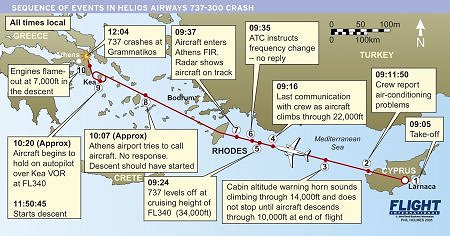Investigator tells Flight International that student pilot tried to fly aircraft to Athens with flightcrew unconscious
The Helios Airways Boeing 737-300 that crashed in Greece on 14 August ran out of fuel as a student private pilot attempted to fly the aircraft towards Athens airport because the flightcrew was unconscious, the head of the Greek Air Accident Investigation and Aviation Safety Board (AAIASB) Capt Akrivos Tsolakis has told Flight International. The aircraft, with six crew and 115 passengers on board, had been airborne for 2h 59min on a flight from Larnaca, Cyprus to Athens that was scheduled to take about 1h 20min.

The engines flamed out due to lack of fuel as the aircraft descended through 7,000ft (2,130m) passing over the island of Evvoia, said Tsolakis, speaking exclusively to Flight International.
No-one survived the impact when the aircraft crashed just after midday local time in hills near Grammatikos, 30km (16nm) north east of Athens airport. Late last week the AAIASB had not released a probable cause for the Helios flight ZU 522 accident, but Tsolakis said the flightcrew were unconscious and that the 737’s cabin altitude alert in the cockpit became active as the aircraft climbed through 14,000ft within 7min of take-off from Larnaca.
The investigators had still not found the mechanism of the cockpit voice recorder (CVR) – just its casing – so the cabin altitude alert status came from the digital flight data recorder (FDR), which Tsolakis said was in “exceptional” condition. The crew would normally have cancelled the alert sound – the same intrusive “horn” alert as for the landing gear – but did not. The last communication between the pilots and air traffic control (ATC) came 11min after take-off as the aircraft climbed through 22,000ft, said Tsolakis.
The aircraft continued its flight coupled to autopilot/flight management system (FMS) as programmed by the pilots, levelling as planned at flight level (FL) 340 about 19min after take-off. It was then observed by the Athens ATC centre to continue its flight-planned route to the VOR navigation beacon on Kea island, where it entered the holding pattern, still on autopilot/FMS.
Greek air force Lockheed Martin F-16 pilots that intercepted the aircraft reported the co-pilot was in his seat but unconscious, and observed two other people on the flightdeck, but not the captain. One has since been confirmed to be one of the male cabin crew, said Tsolakis, probably sustained by using one of the portable oxygen units from the cabin. This air steward, a new student pilot who has “a few hours on Cessnas” according to Tsolakis, hesitated for some time before deciding that he had no choice but to try to fly the aircraft himself.
Also reported by the F-16 pilots was the fact that the passenger oxygen masks were deployed and there appeared to be no activity in the cabin.
At 11:50:45, just over 13min before the crash, the steward decided he had to act and pushed the aircraft into a descent, possibly resulting in the autopilot disconnect. Tsolakis said the 737’s airspeed increased and the aircraft turned right, descending over the sea, then left over the island of Evvoia heading toward Athens. Passing 7,000ft the engines flamed out, and the aircraft crashed in hills near Grammatikos, north east of Athens. Contrary to many reports, Tsolakis said that an order to shoot the aircraft down was never given.
Tsolakis said he is concerned at what he has found in the 737’s engineering records. The air conditioning system of the aircraft (5B-DBY) had needed rectification five times in last two months, and there had been internal questions among Helios engineers about the aircraft’s fitness to fly, he said.
Helios confirms the aircraft had suffered a decompression incident in December 2004 on a Warsaw-Larnaca flight, but says the fault had been rectified.
Cypriot police have collected the engineering records for the aircraft and the airline for examination by the Cyprus judiciary and the Greek AAIASB.
DAVID LEARMOUNT/LONDON
Depressurisation drill - the need for pilot urgency Depressurisation drill for pilots has to be completed from memory within about 40s. On receipt of the cabin altitude warning, the pilots pick up their oxygen masks from their adjacent stowage – a one-hand action. Its head-harness inflates making the fitting of the mask very quick, then deflates, pulling the mask firmly over the mouth and nose. Crew communication via the in-mask microphone is checked. Then cabin altitude is verified on the overhead panel to ensure the warning is not false. If it is real, the pressurisation outflow valve is set to “manual”, and the non-handling pilot closes it. The seat-belt sign is switched on and the emergency descent procedure follows, and continues to minimum safe altitude or 10,000ft (3,000m), whichever is higher. In two cases of airliner depressurisation, the captain lost consciousness, leaving only the first officer flying the aircraft. In both cases a flight attendant collapsed in the cockpit. In a 1998 incident the captain of a UK-registered Boeing 737 lost consciousness at 35,000ft when his oxygen mask became entangled with his spectacles. A flight attendant who tried to help collapsed. In 1996 the captain of a US-registered Boeing 727 collapsed at 33,000ft when he delayed putting on his mask, and the flight engineer also collapsed. On both occasions the cabin emergency oxygen systems for passengers worked well. |
Source: Flight International
















